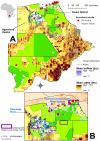Buffalo, bush meat, and the zoonotic threat of brucellosis in Botswana
- PMID: 22412932
- PMCID: PMC3297602
- DOI: 10.1371/journal.pone.0032842
Buffalo, bush meat, and the zoonotic threat of brucellosis in Botswana
Abstract
Background: Brucellosis is a zoonotic disease of global importance infecting humans, domestic animals, and wildlife. Little is known about the epidemiology and persistence of brucellosis in wildlife in Southern Africa, particularly in Botswana.
Methods: Archived wildlife samples from Botswana (1995-2000) were screened with the Rose Bengal Test (RBT) and fluorescence polarization assay (FPA) and included the African buffalo (247), bushbuck (1), eland (5), elephant (25), gemsbok (1), giraffe (9), hartebeest (12), impala (171), kudu (27), red lechwe (10), reedbuck (1), rhino (2), springbok (5), steenbok (2), warthog (24), waterbuck (1), wildebeest (33), honey badger (1), lion (43), and zebra (21). Human case data were extracted from government annual health reports (1974-2006).
Findings: Only buffalo (6%, 95% CI 3.04%-8.96%) and giraffe (11%, 95% CI 0-38.43%) were confirmed seropositive on both tests. Seropositive buffalo were widely distributed across the buffalo range where cattle density was low. Human infections were reported in low numbers with most infections (46%) occurring in children (<14 years old) and no cases were reported among people working in the agricultural sector.
Conclusions: Low seroprevalence of brucellosis in Botswana buffalo in a previous study in 1974 and again in this survey suggests an endemic status of the disease in this species. Buffalo, a preferred source of bush meat, is utilized both legally and illegally in Botswana. Household meat processing practices can provide widespread pathogen exposure risk to family members and the community, identifying an important source of zoonotic pathogen transmission potential. Although brucellosis may be controlled in livestock populations, public health officials need to be alert to the possibility of human infections arising from the use of bush meat. This study illustrates the need for a unified approach in infectious disease research that includes consideration of both domestic and wildlife sources of infection in determining public health risks from zoonotic disease invasions.
Conflict of interest statement
Figures





References
-
- Pappas G, Papadimitriou P, Akritidis N, Christou L, Tsianos EV. The new global map of human brucellosis. The Lancet Infectious Diseases. 2006;6:91–99. - PubMed
-
- Godfroid J, Scholz H, Barbier T, Nicolas C, Wattiau P, et al. Brucellosis at the animal/ecosystem/human interface at the beginning of the 21st century. Preventive Veterinary Medicine. 2011;102:118–131. - PubMed
-
- Davis DS. Brucellosis in wildlife. Animal brucellosis. 1990:321–334.
-
- Joly DO, Messier F. The effect of bovine tuberculosis and brucellosis on reproduction and survival of wood bison in Wood Buffalo National Park. Journal of Animal Ecology. 2005;74:543–551.
Publication types
MeSH terms
Grants and funding
LinkOut - more resources
Full Text Sources
Medical

